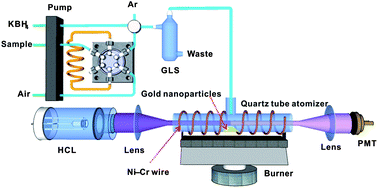In-atomizer atom trapping on gold nanoparticles for sensitive determination of mercury by flow injection cold vapor generation atomic absorption spectrometry
Abstract
An in-atomizer atom trapping method based on coating gold nanoparticles onto the inner wall of a quartz tube atomizer was firstly developed and combined with flow injection cold vapor generation for the accurate determination of mercury at low μg L−1 levels by atomic absorption spectrometry. Mercury vapor generated by reducing Hg2+ with hydrochloric acid–tetrahydroborate was efficiently trapped on the surface of gold nanoparticles that were coated on the interior wall of the quartz tube atomizer prior to the determination. In situ desorption and determination of mercury was achieved by increasing the voltage (thus the temperature) to 30 V. The influence of instrumental parameters and experimental conditions on the generation, trapping and desorption of mercury vapor, as well as interference from concomitant elemental ions was investigated. A detection limit of 0.01 μg L−1 was obtained based on a 5.0 mL sampling volume. The precision was better than 4.0% at 0.5 μg L−1. Three spiked water samples and two Certified Reference Materials (dogfish muscle, DORM-4 and human hair powder GBW07601a) were analyzed to validate the accuracy of the proposed method.

- This article is part of the themed collection: 2014 Young Analytical Scientists

 Please wait while we load your content...
Please wait while we load your content...